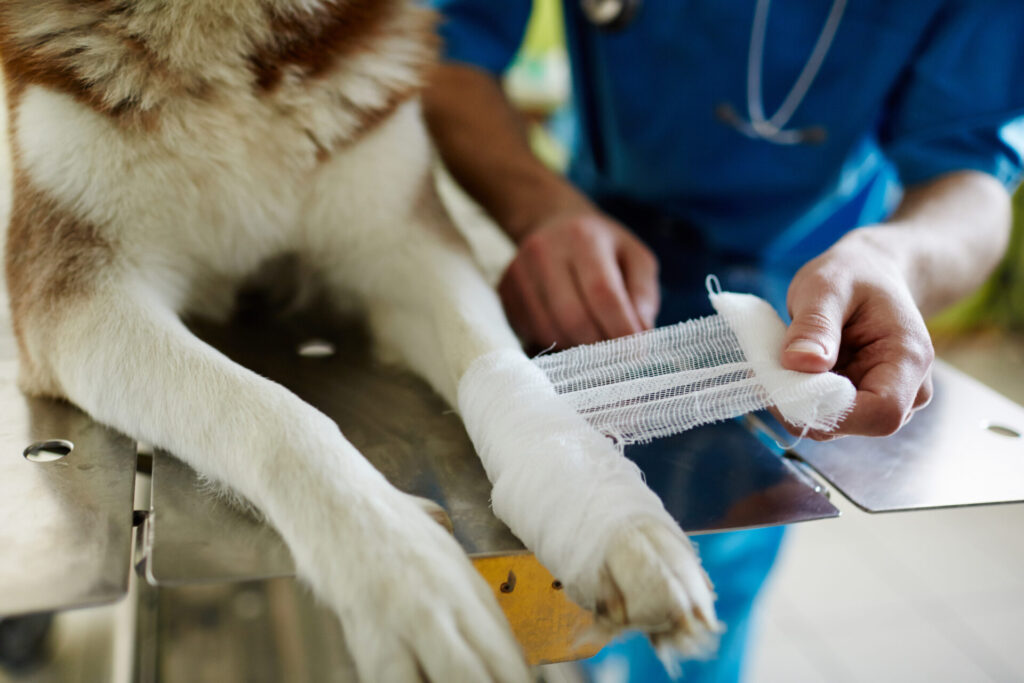Knees in both humans and dogs are complex, ultimately it does require a professional veterinarian to diagnose the extent of your dog’s knee injury. However there are some signs and symptoms to be aware of so that you, the owner can get a general sense of what may be going on with your dog’s injured leg.
First, this article will review the differences between a dog’s knee that is sprained and one that has a full ACL tear. Second, what are some of the signs and symptoms to look for as the owner, and third what treatment options are available for sprained dog knees and full ACL tears.
What Is The Difference Between A Sprain and A Tear In A Dog’s Knee?
A sprain is damage to the ligament that connects to the bone. There can be many levels associated with a sprain from mild to severe. Sprains can affect every joint where ligaments connect to bone. The knee, specifically the ACL, is complex and even if mildly sprained may lead to further injury to the knee.
A mild sprain is a stretched ligament with tiny microscopic tears. This may lead to some limping, however the injury will heal with minimal scar tissue over time on its own or with the assistance of a knee brace. (1)
[ad#topbanner]Moderate to severe sprains in a dog’s knee are ACL tears. A sprain becomes an ACL tear when the ligament experiences greater depth of tearing than the microscopic tear seen in the sprain.
Your dog may not be able to bear any weight at all on the injured leg or the limp may be severe when the ACL has been torn.
Both sprains and ACL tears are in fact varying degrees of tears to the ligament surrounding the knee joint. As the owner you will know the severity of the injury based on your dog’s ability to bear weight on the injured knee; however, it is always best to consult with a medical professional for diagnosis.
[ad#topbanner]Signs And Symptoms Of Sprains Versus ACL Tears
Both sprains and full ACL tears in dog’s happen acutely and are typically (at least originally) as a single blunt trauma. Many owners report hearing their dog yelp out in pain, and when a full tear has occurred will often hear an actual ‘pop’ sound.
With a sprain, the dog will typically be able to bear some weight on the injured leg, and may even continue to play and run around on the injured knee, even while they limp.
A full ACL tear will leave your dog lifting its injured leg up and hopping around on three legs, in noticeable pain. The owner will not hear an audible popping sound with a sprain, but if within hearing range will hear a sudden rupture to the knee ligament.
Either way, as the owner it is best to bring your dog to a veterinarian to determine the extent of the injury and what the best course of treatment should be for your pet.
Treatments For A Sprained Dog Knee And An ACL Tear
A dog who sprains their knee will not require surgery. Generally a combination of conservative treatment, a knee brace, and some rest will resolve the issue with minimal scar tissue. It is imperative to recognize that while the dog may recover with relative ease from a sprained knee, that the knee will be more susceptible to further damage that may lead to a full ACL tear requiring surgery.
Depending on the size, weight, age, and a few other factors, when a dog tears its ACL very often the best course of action is surgery. It is not always necessary to operate on the injured knee; however, in most cases this will help not only resolve the injury but prevent further deterioration of the knee joint in the future.
If you and your veterinarian choose surgery as the most appropriate form of treatment, then you will become familiar with the four primary types of dog knee surgery.
Regardless of the level of ligament tear or tears to your dog’s knee joint, these injuries ought to be taken seriously so as to offer your dog a long life of mobility free from pain.
Please be sure to consult with a professional for diagnosis and treatment of your dog’s knee injury.
[ad#topbanner]Sources Cited:



Can someone please help can a vet determine a timeframe of an injury by looking at xrays?